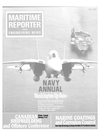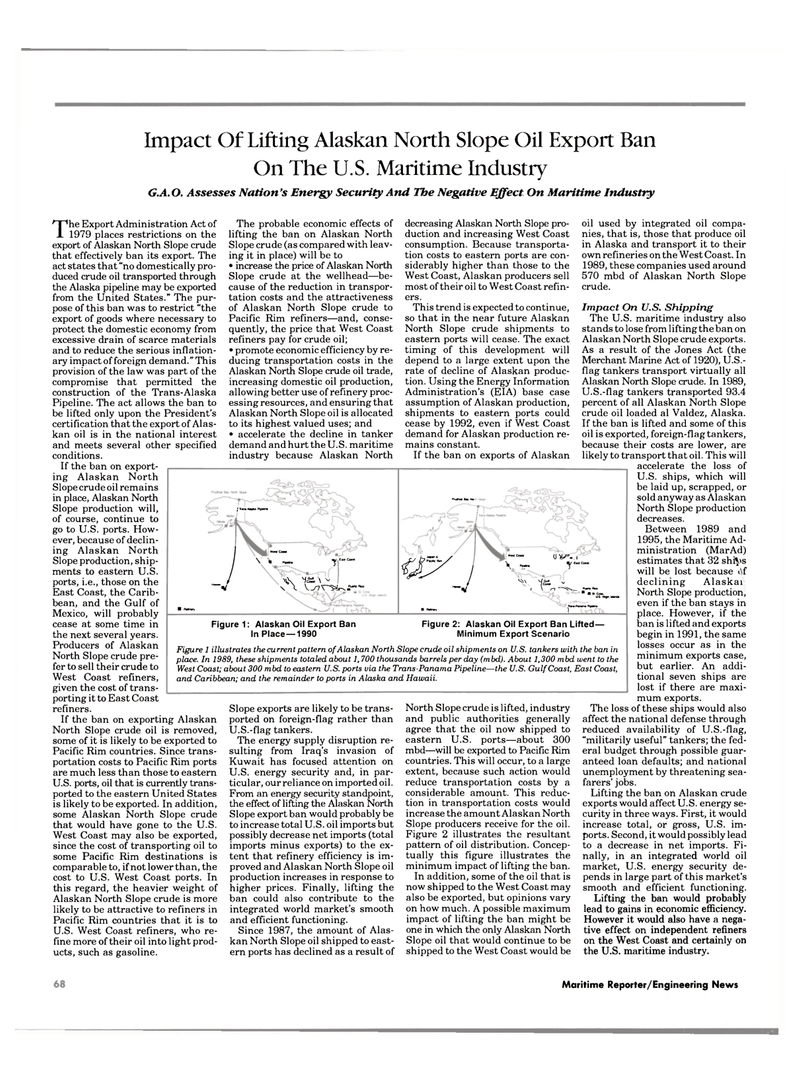
Page 68: of Maritime Reporter Magazine (February 1991)
Read this page in Pdf, Flash or Html5 edition of February 1991 Maritime Reporter Magazine
Impact Of Lifting Alaskan North Slope Oil Export Ban
On The U.S. Maritime Industry
G.A.O. Assesses Nation's Energy Security And The Negative Effect On Maritime Industry
The Export Administration Act of 1979 places restrictions on the export of Alaskan North Slope crude that effectively ban its export. The act states that "no domestically pro- duced crude oil transported through the Alaska pipeline may be exported from the United States." The pur- pose of this ban was to restrict "the export of goods where necessary to protect the domestic economy from excessive drain of scarce materials and to reduce the serious inflation- ary impact of foreign demand." This provision of the law was part of the compromise that permitted the construction of the Trans-Alaska
Pipeline. The act allows the ban to be lifted only upon the President's certification that the export of Alas- kan oil is in the national interest and meets several other specified conditions.
If the ban on export- ing Alaskan North
Slope crude oil remains in place, Alaskan North
Slope production will, of course, continue to go to U.S. ports. How- ever, because of declin- ing Alaskan North
Slope production, ship- ments to eastern U.S. ports, i.e., those on the
East Coast, the Carib- bean, and the Gulf of
Mexico, will probably cease at some time in the next several years.
Producers of Alaskan
North Slope crude pre- fer to sell their crude to
West Coast refiners, given the cost of trans- porting it to East Coast refiners.
If the ban on exporting Alaskan
North Slope crude oil is removed, some of it is likely to be exported to
Pacific Rim countries. Since trans- portation costs to Pacific Rim ports are much less than those to eastern
U.S. ports, oil that is currently trans- ported to the eastern United States is likely to be exported. In addition, some Alaskan North Slope crude that would have gone to the U.S.
West Coast may also be exported, since the cost of transporting oil to some Pacific Rim destinations is comparable to, if not lower than, the cost to U.S. West Coast ports. In this regard, the heavier weight of
Alaskan North Slope crude is more likely to be attractive to refiners in
Pacific Rim countries that it is to
U.S. West Coast refiners, who re- fine more of their oil into light prod- ucts, such as gasoline.
The probable economic effects of lifting the ban on Alaskan North
Slope crude (as compared with leav- ing it in place) will be to • increase the price of Alaskan North
Slope crude at the wellhead—be- cause of the reduction in transpor- tation costs and the attractiveness of Alaskan North Slope crude to
Pacific Rim refiners—and, conse- quently, the price that West Coast refiners pay for crude oil; • promote economic efficiency by re- ducing transportation costs in the
Alaskan North Slope crude oil trade, increasing domestic oil production, allowing better use of refinery proc- essing resources, and ensuring that
Alaskan North Slope oil is allocated to its highest valued uses; and • accelerate the decline in tanker demandandhurttheU.S. maritime industry because Alaskan North
Slope exports are likely to be trans- ported on foreign-flag rather than
U.S.-flag tankers.
The energy supply disruption re- sulting from Iraq's invasion of
Kuwait has focused attention on
U.S. energy security and, in par- ticular, our reliance on imported oil.
From an energy security standpoint, the effect of lifting the Alaskan North
Slope export ban would probably be to increase total U.S. oil imports but possibly decrease net imports (total imports minus exports) to the ex- tent that refinery efficiency is im- proved and Alaskan North Slope oil production increases in response to higher prices. Finally, lifting the ban could also contribute to the integrated world market's smooth and efficient functioning.
Since 1987, the amount of Alas- kan North Slope oil shipped to east- ern ports has declined as a result of decreasing Alaskan North Slope pro- duction and increasing West Coast consumption. Because transporta- tion costs to eastern ports are con- siderably higher than those to the
West Coast, Alaskan producers sell most of their oil to West Coast refin- ers.
This trend is expected to continue, so that in the near future Alaskan
North Slope crude shipments to eastern ports will cease. The exact timing of this development will depend to a large extent upon the rate of decline of Alaskan produc- tion. Using the Energy Information
Administration's (EIA) base case assumption of Alaskan production, shipments to eastern ports could cease by 1992, even if West Coast demand for Alaskan production re- mains constant.
If the ban on exports of Alaskan
North Slope crude is lifted, industry and public authorities generally agree that the oil now shipped to eastern U.S. ports—about 300 mbd—will be exported to Pacific Rim countries. This will occur, to a large extent, because such action would reduce transportation costs by a considerable amount. This reduc- tion in transportation costs would increase the amount Alaskan North
Slope producers receive for the oil.
Figure 2 illustrates the resultant pattern of oil distribution. Concep- tually this figure illustrates the minimum impact of lifting the ban.
In addition, some of the oil that is now shipped to the West Coast may also be exported, but opinions vary on how much. A possible maximum impact of lifting the ban might be one in which the only Alaskan North
Slope oil that would continue to be shipped to the West Coast would be oil used by integrated oil compa- nies, that is, those that produce oil in Alaska and transport it to their own refineries on the West Coast. In 1989, these companies used around 570 mbd of Alaskan North Slope crude.
Impact On U.S. Shipping
The U.S. maritime industry also stands to lose from lifting the ban on
Alaskan North Slope crude exports.
As a result of the Jones Act (the
Merchant Marine Act of 1920), U.S.- flag tankers transport virtually all
Alaskan North Slope crude. In 1989,
U.S.-flag tankers transported 93.4 percent of all Alaskan North Slope crude oil loaded al Valdez, Alaska.
If the ban is lifted and some of this oil is exported, foreign-flag tankers, because their costs are lower, are likely to transport that oil. This will accelerate the loss of
U.S. ships, which will be laid up, scrapped, or sold anyway as Alaskan
North Slope production decreases.
Between 1989 and 1995, the Maritime Ad- ministration (MarAd) estimates that 32 shi^*s will be lost because i f declining Alaskai
North Slope production, even if the ban stays in place. However, if the ban is lifted and exports begin in 1991, the same losses occur as in the minimum exports case, but earlier. An addi- tional seven ships are lost if there are maxi- mum exports.
The loss of these ships would also affect the national defense through reduced availability of U.S.-flag, "militarily useful" tankers; the fed- eral budget through possible guar- anteed loan defaults; and national unemployment by threatening sea- farers' jobs.
Lifting the ban on Alaskan crude exports would affect U.S. energy se- curity in three ways. First, it would increase total, or gross, U.S. im- ports. Second, it would possibly lead to a decrease in net imports. Fi- nally, in an integrated world oil market, U.S. energy security de- pends in large part of this market's smooth and efficient functioning.
Lifting the ban would probably lead to gains in economic efficiency.
However it would also have a nega- tive effect on independent refiners on the West Coast and certainly on the U.S. maritime industry. 1 Trans-AimM Ppetne
P-uroe Bay fo
J
V
Weil COM! \ il PnM yiEasl 00351
TAV \ v \ \ V ^ ^ wsj
V
Weu Co** (J -1
V 1/ E«51 Coast * J
SvY V/GO« 7 Coast v
J V n PuenoReo . . „ ^ ^ • Refinery • Rrinary Trans-Panama Pipetne 1
Figure 1: Alaskan Oil Export Ban
In Place—1990
Figure 2: Alaskan Oil Export Ban Lifted —
Minimum Export Scenario
Figure 1 illustrates the current pattern of Alaskan North Slope crude oil shipments on U.S. tankers with the ban in place. In 1989, these shipments totaled about 1, 700 thousands barrels per day (mbd). About 1,300 mbd went to the
West Coast; about 300 mbd to eastern U.S. ports via the Trans-Panama Pipeline—the U.S. Gulf Coast, East Coast, and Caribbean; and the remainder to ports in Alaska and Hawaii. 70
Maritime Reporter/Engineering News

 67
67

 69
69
